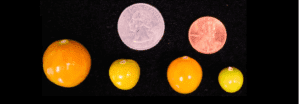Physalis Blog Post
Biology Minute: Differentiating Between Groundcherry and Goldenberry
In the earliest stages of growth, groundcherries and goldenberries appear quite similar, however as they develop the difference between them becomes apparent. From plant architecture to fruit taste, these two species have differentiated themselves over the course of their evolution.

Goldenberry (P. peruviana) originated in the Andes Mountains of South America and presently grows wild around the world in temperate and tropical regions where it is considered a perennial. The plant has a woody stem and produces fruits surrounded by a husk that remain on the plant as the fruit matures. When the fruit is ripe, it is harvested directly from the plant. The fruit itself is sweet and tangy and is similar in size to a quarter
Groundcherry (P. pruinosa) is believed to be native to parts of Mexico and Central America. The species first became prominent in the Northeastern United States when it was widely grown by the Pennsylvania Dutch in the early 1800s. Although the species grows in northern regions of the United States, it does not tolerate freezing temperatures and is therefore grown as an annual. Like the goldenberry, groundcherry fruits are enveloped by a husk and must be removed before consumption. Groundcherries drop their fruit when ripe and must be harvested from the ground (hence the name groundcherries). The plant itself has an herbaceous stem and produces small sweet fruits with a diameter roughly the size of a penny.

